
Panda is a plant genus of the family Pandaceae. It contains only one known species, Panda oleosa, native to western and central Africa.
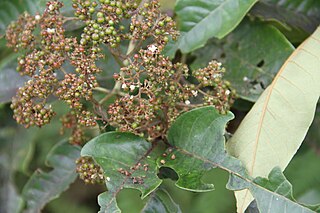
Harungana is a genus of African flowering plants within the St. Johnswort family, Hypericaceae.

Irvingia gabonensis is a species of African trees in the genus Irvingia, sometimes known by the common names wild mango, African mango, or bush mango. They bear edible mango-like fruits, and are especially valued for their fat- and protein-rich nuts.
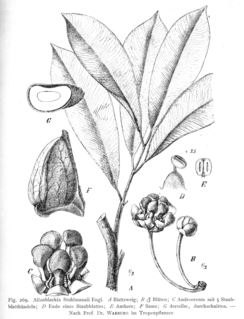
Allanblackia is a genus of flowering plant in the family Clusiaceae. Molecular phylogenetic analyses indicate that is it nested in the dioecious Garcinia. The genus name commemorates Allan Black.

Garcinia kola (bitter kola is a species of flowering plant belonging to the Mangosteen genus Garcinia of the family Clusiaceae. It is found in Benin, Cameroon, The Gambia, Democratic Republic of the Congo, Ivory Coast, Mali, Gabon, Ghana, Liberia, Nigeria, Senegal and Sierra Leone. Its natural habitat is subtropical or tropical moist lowland forests.

Monodora myristica, the calabash nutmeg, is a tropical tree of the family Annonaceae or custard apple family of flowering plants. It is native to Angola, Benin, Cameroon, the Central African Republic, the Democratic Republic of the Congo, Equatorial Guinea, Gabon, Ghana, Guinea-Bissau, Ivory Coast, Kenya, Liberia, Nigeria, the Republic of the Congo, Sierra Leone, Sudan, Tanzania, Togo and Uganda. In former times, its seeds were widely sold as an inexpensive nutmeg substitute. This is now less common outside its region of production. Other names of calabash nutmeg include Jamaican nutmeg, African nutmeg, ehuru, ariwo, awerewa, ehiri, airama, African orchid nutmeg, muscadier de Calabash and lubushi.
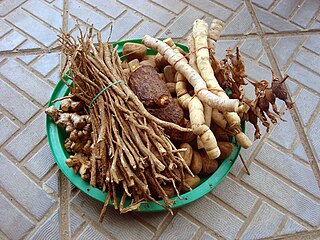
Corynanthe johimbe, common name yohimbe, is a plant species in the family Rubiaceae native to western and central Africa. Extracts from yohimbe have been used in traditional medicine in West Africa as an aphrodisiac and have been marketed in developed countries as dietary supplements.
Triplochiton is a genus of flowering plants in the family Malvaceae. It is a small genus of trees comprising tall tropical African trees with palmately lobed alternate leaves like those of the maple and being included in the Sterculiaceae subfamily of Malvaceae.

Margaritaria discoidea is a tree in the family Phyllanthaceae, commonly known as the pheasant-berry, egossa red pear or bushveld peacock-berry. These trees are native to the warmer, higher rainfall areas of Africa.

Omphalocarpum elatum Miers is a tall, tropical African tree belonging to the family Sapotaceae, remarkable for the large fruits growing directly from the trunk, and in many ways resembling the Lecythidaceae genus Napoleonaea. It is found in Equatorial Guinea, Sierra Leone, Ghana, the Central African Republic, Gabon, the Democratic Republic of the Congo, Nigeria, Liberia, Cameroon, Côte d’Ivoire and Angola in the south. The fruits are favoured by elephants, the only animals able to break through the hard shell. They do this by skewering the fruit with a tusk while using their trunk to brace it against the ground. Having passed through the elephant's digestive tract, seeds germinate more readily. Although not yet endangered, the tree's life cycle is tied to that of forest elephants, and may become threatened in regions where elephant populations are under pressure.
Allanblackia oil is a vegetable oil that comes from the seeds of trees of the genus Allanblackia. This tree can be found in the wet tropical belt of Africa. Because of its unique blend of fatty acids, the oil from Allanblackia seeds has melting properties that make it excellent to use as structuring fat in food products, e.g. margarines.
Brachystegia eurycoma, a plant in the family Fabaceae, is a sizable species of tree found in southern Nigeria and western Cameroon. It has a spreading, flattened crown.

Strombosia pustulata is a species of tree in the family Olacaceae. It is native to the rainforests of tropical West and Central Africa. Common names for this tree include itako in Nigeria, afina in Ghana, poé in Abé spoken in Côte d'Ivoire and mba esogo in Equatorial Guinea.
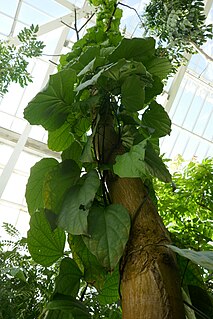
Lannea welwitschii is a species of tree in the family Anacardiaceae. It is native to the tropical rainforests of West and Central Africa. The timber is used to make furniture and utensils and for many other purposes, the fruits can be eaten, and the bark is used to produce a dye, for making rope and in traditional medicine.
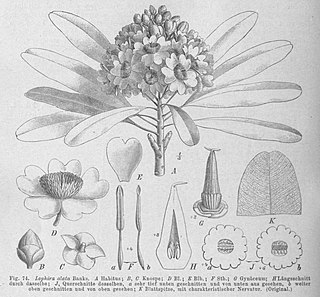
Lophira lanceolata, commonly known as the dwarf red ironwood, is a species of tree in the family Ochnaceae which is native to tropical West and Central Africa. The timber is used for heavy construction, an edible oil can be extracted from the seeds and various parts of the plant are used in traditional medicine.

Brachystegia laurentii, a plant in the family Fabaceae, is a species of large tree found in western Cameroon, Gabon, Equatorial Guinea, the Democratic Republic of the Congo and the Republic of the Congo. It has a dense, umbrella-shaped crown. The wood is known as bomanga and has many uses in building and construction.

Garcinia mannii is a dioecious and evergreen flowering tree in the family Clusiaceae or Guttiferae. The specific epithet (mannii) honors German botanist Gustav Mann. It is not to be confused with Garcinia mannii var. brevipedicellata, a synonym for Garcinia brevipedicellata.
Strychnos icaja is a species belonging to the plant family Loganiaceae, native to West Tropical Africa. It is a very large, tropical rainforest liana which may attain a length of 100 m (330 ft).
Albizia altissima is a low branching tree within the Fabaceae family, it grows along river banks in the Lower and Upper Guinea forests..
Chrysophyllum africanum is a medium sized tree within the Sapotaceae family. It is sometimes known as the African Star Apple along with the closely related Chrysophyllum Albidum. Both species have similar leaf indumentum and are widespread in the Lower and Upper Guinea forest mosaic.













